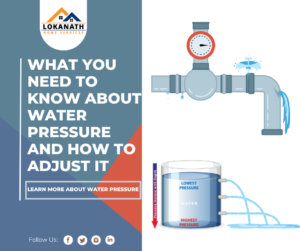What You Need to Know About Water Pressure and How to Adjust It

Water pressure is a crucial factor in maintaining a well-functioning plumbing system. Whether you're dealing with low or high water pressure, understanding how it works and how to adjust it can help you prevent potential plumbing issues and ensure a consistent and comfortable water supply in your home. In this article, we will explore the fundamentals of water pressure, signs of low or high pressure, and practical tips on how to adjust it effectively.
Understanding Water Pressure:
Water pressure refers to the force at which water flows through your pipes and fixtures. It is typically measured in pounds per square inch (PSI) and can vary based on several factors, including the elevation of your property, the distance from the water source, and the condition of your plumbing system. Standard residential water pressure ranges from 40 to 80 PSI.
Signs of Low Water Pressure:
Low water pressure can be frustrating, leading to weak flows from faucets, slow-filling toilets, and inefficient operation of appliances like washing machines and dishwashers. Common causes of low water pressure include clogged pipes, faulty pressure regulators, water leaks, or inadequate supply from the main water source. If you're experiencing consistently low water pressure, it may be necessary to investigate and address the underlying issue.
Signs of High Water Pressure:
High water pressure can cause damage to your plumbing system over time, leading to leaks, burst pipes, and premature wear of fixtures. Signs of excessive water pressure include banging or rattling pipes, leaking faucets, running toilets, and even appliance malfunctions. It is important to identify and address high water pressure promptly to avoid potential damage and unnecessary repairs.
How to Adjust Water Pressure:
a. Increasing Water Pressure:
-
- Check the water pressure regulator: Locate the pressure regulator near the main water supply entry point to your home. Adjust it using a screwdriver to increase the pressure gradually. If you're unsure about making adjustments, consult a professional plumber.
- Clear clogged pipes: Blockages in your plumbing system can restrict water flow and decrease pressure. Clear any clogs in your pipes by using appropriate cleaning methods or seeking professional assistance.
- Replace faulty fixtures: Old or worn-out fixtures may restrict water flow, contributing to low pressure. Consider replacing them with newer, high-efficiency models to improve water pressure.
b. Decreasing Water Pressure:
- Install a pressure-reducing valve (PRV): If your water pressure is consistently high, installing a PRV can help regulate it. A PRV reduces the pressure entering your home, protecting your plumbing system and appliances.
- Check for water leaks: Undetected leaks can cause a drop in water pressure. Inspect your plumbing system regularly for any signs of leaks, such as damp spots, water stains, or unusually high water bills. Repair leaks promptly to maintain optimal water pressure.
- Consult a professional plumber: If you're uncertain about adjusting water pressure or suspect a more complex issue, it's best to seek professional assistance. A licensed plumber can assess your system, identify the underlying causes, and provide appropriate solutions.
Understanding water pressure and knowing how to adjust it is essential for maintaining a functional and efficient plumbing system in your home. Whether you're dealing with low or high water pressure, promptly addressing the issue can help prevent costly repairs and ensure a consistent water supply. Remember, if you're unsure about making adjustments or suspect a more significant problem, it's always advisable to consult a professional plumber for expert guidance.

